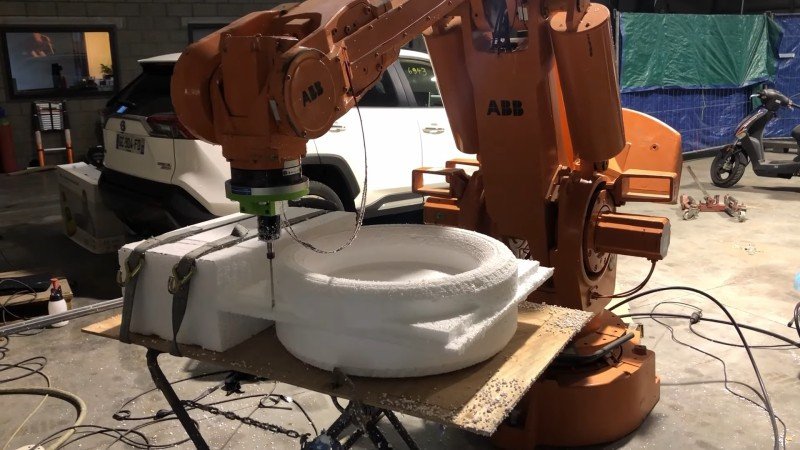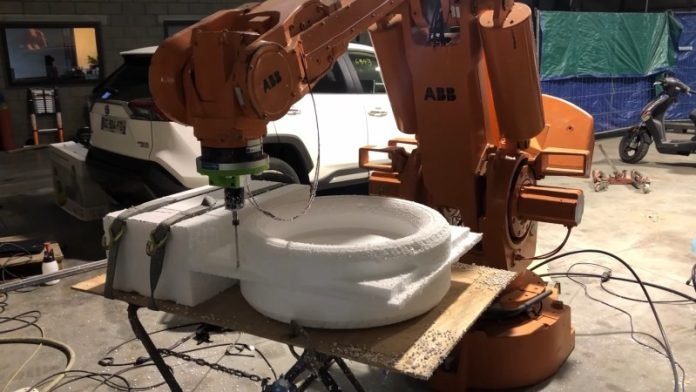

Robots have come a long way since the late 90s, but who says they can’t learn new tricks? In fact, one industrial beast from that era has been repurposed in an unexpected way: as a giant CNC router. The ABB IRB6400, a six-axis, floor-mounted industrial machine that previously had a long career welding at a Eurorail factory in Austria, was acquired by hobbyist Brian Brocken. After fixing and upgrading the robot’s controller, Brian was able to bring the machine back to life and use it to carve foam blocks into complex shapes. This build seems to be a significant escalation from Brian’s previous large-format CNC machine, and one can’t help but wonder what interesting projects he has in store for this new tool. How did Brian manage to repurpose this old robot, what other potential uses could there be for industrial robots beyond their original purpose, and what other obsolete technologies could be given a new lease on life with some DIY tinkering?
Top Stories This Week
Hardware Business News
Exxon’s New ‘Advanced Recycling’ Plant Raises Environmental Concerns

ExxonMobil has recently opened one of the largest chemical recycling plants in North America at its petrochemical refinery complex in Baytown, Texas. While chemical recycling is hailed as an innovative and environmentally friendly solution to the global plastic crisis, critics warn that such facilities are dangerous and actually do little to stop plastic waste from ending up in landfills and the ocean. Furthermore, recent studies suggest that chemical recycling is worse for the environment than traditional mechanical recycling in terms of greenhouse gas emissions and water use. ExxonMobil’s Baytown facility uses pyrolysis, an energy-intensive process that generates hazardous pollutants, and which many environmental advocates argue is not true recycling. How much impact will ExxonMobil’s chemical recycling facility have on the environment, is it a distraction from the need to reduce plastic production, as critics suggest, and are there alternative solutions that companies like ExxonMobil could pursue instead?
Carbon Robotics Bags $30m To Fight The War On Weeds With Autonomous Laser Bots

Carbon Robotics, a Seattle-based robotics company, has developed an autonomous robot called the LaserWeeder, which uses AI and CO2 laser technology to target and eliminate weeds in fields with millimeter accuracy. With the herbicide resistance showing up in the weed population and the shortage of labor, farmers are turning to innovative technologies like the LaserWeeder. The company has already eliminated more than 500 million weeds across 40 different crops, and in 2023, it will deliver the LaserWeeder across 17 US states and three provinces in Canada. What challenges are specialty crop farmers facing that the LaserWeeder addresses, how does the LaserWeeder help to reduce the need for herbicides and over-tilling, and what does Carbon Robotics plan to do with its new funding?
China Strikes Back: Newport Wafer Fab Closure & Micron Investigation Explained

As the West continues to tighten restrictions against China’s access to semiconductors, China has started to fight back with the development of its own semiconductor tools, launching probes into Western facilities like Micron Technology located in China and even threatening jobs in the West via fab closures such as Newport Wafer Fab, owned by Chinese company WingTech through Nexperia, and raising national security concerns with the UK government. This struggle impacts supply chains, automotive-grade parts, and military-grade hardware production while also posing risks of industrial espionage, IP theft, and falling stock values for Western companies hesitant to establish new foundries and facilities in China due to escalating cybersecurity risks. Why does Newport Wafer Fab risk closure, why is China looking into Micron, and what does this mean for the West?
US Begins Study Of Possible Rules To Regulate AI Like ChatGPT

As artificial intelligence continues to grow in popularity and usage, concerns about its accountability have arisen. The Biden administration has announced that it is seeking public input on potential measures to hold AI systems accountable for their impact on national security and education. The National Telecommunications and Information Administration, a Commerce Department agency that advises the White House on telecommunications and information policy, is seeking feedback on whether measures could be put in place to ensure AI systems are legal, effective, ethical, safe, and trustworthy. In light of this news, it is important to consider the potential consequences and benefits of AI technology. What are some of the potential harms that AI systems could cause, how can we ensure that these systems are trustworthy and beneficial, what responsibility do tech companies have in ensuring the safety of their AI products?
Hardware Engineering News
Google AI Supercomputer Shows The Potential Of Optical Interconnects

Google has released details of its implementation of optical interconnects between servers and chips in its data centres, describing the technology as key to reaching zettascale computing in an energy-efficient way. The company said that the TPU v4 supercomputer was the first to include a circuit-switched optical interconnect, with 48 optical circuit switches connecting all 64 racks and 4,096 TPUs. Google said that the interconnect and its high bandwidth allowed each rack to be deployed independently, with the flexibility of optics making it possible to adapt the topology on the fly depending on the application. How does the TPU v4 chip compare to Nvidia’s A100 chip and Graphcore’s AI chip, how will optical interconnects change the face of computing, and what other applications could benefit from Google’s use of the technology?
Samsung Fab Data Leak: How ChatGPT Exposed Sensitive Information

Recently, employees from Samsung Fab had been permitted to use ChatGPT, an increasingly popular AI model with numerous capabilities yet certain limitations, to aid in work tasks like coding, notes, and explanations, but over the course of 20 days, three occasions have led to sensitive data being stored on ChatGPT servers due to a lack of due-diligence by OpenAI and the company. Engineers need to exercise caution when using ChatGPT in the workplace, especially for commercial products, as proprietary code may be subject to terms of service, code examination is crucial to catch mistakes, engineers hold responsibility for any errors, and adversarial attacks pose a threat to the security and integrity of AI models. Why has ChatGPT become immensely popular, what exactly happened at Samsung, and why should engineers be cautious of ChatGPT?
MIT Researchers Create Algorithm To Stop Drones From Colliding Midair

MIT researchers have developed an updated version of their trajectory-planning system called Robust MADER that allows drones to safely work together in the same airspace without crashing into each other. This new system is able to generate collision-free trajectories even when there are delays in communications between agents. The researchers hope to test the system outdoors and outfit drones with visual sensors to detect obstacles and optimize trajectory planning. How scalable is Robust MADER, and can it be used in larger-scale operations such as delivery drones, how will visual sensors improve the system’s efficiency and safety, and will this technology be widely adopted?
Hardware R&D News
Electronic Skin: The Cutting-Edge Technology Taking The World by Storm

Wearable technology has revolutionized the way we monitor our health, with smartwatches and fitness trackers becoming increasingly popular, however, their discomfort and limited compatibility with our bodies can be a persistent issue. This is where electronic skin technology comes in, an emerging technology that has the potential to revolutionize health monitoring by providing a more comfortable and seamless experience. What are the key components of electronic skin technology, what are some of the latest developments in this field, and how is electronic skin technology being used to enhance prosthetics and skin grafts?
Fully Recyclable Printed Electronics Produced Using Water Instead Of Toxic Chemicals

Duke University engineers have made a ground-breaking announcement that could change the way electronics are produced and recycled. They have developed the world’s first fully recyclable printed electronics that use water instead of hazardous chemicals in the fabrication process. The new method was led by electrical/computer engineering professor Aaron Franklin and his team. By using carbon-based inks of semiconducting carbon nanotubes, conductive graphene, and insulating nanocellulose, they created fully functional, fully recyclable, and water-based transistors. This breakthrough could revolutionize the manufacturing process for electronic components, such as screens and displays. How will the new technology change the electronics industry, what are the implications for electronic waste management, what challenges remain in adapting the new process to other electronic components?
Open-Source Hardware News
Open-Source Smartwatch Integrates ESP32 MCU

ThePiHut has introduced the open-source Watchy ePaper smartwatch, powered by an ESP32 module, featuring a range of peripherals such as a 3-axis accelerometer, vibration motor, LiPo battery connector, and many other features. The device comes with Bluetooth and Wi-Fi connectivity, a 1.54″ ePaper display with 200 x 200 resolution, and also features a Bosch IMU optimized for wearable applications and a motion-triggered interrupt. The product page lists various documentation including a Watchy Wiki page and a GitHub repository. What are the key features of Watchy that make it stand out from other smartwatches in the market, how does the device’s open-source nature impact the user experience, and can users customize the device beyond what is available on the product page?
